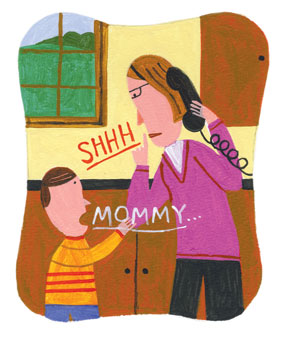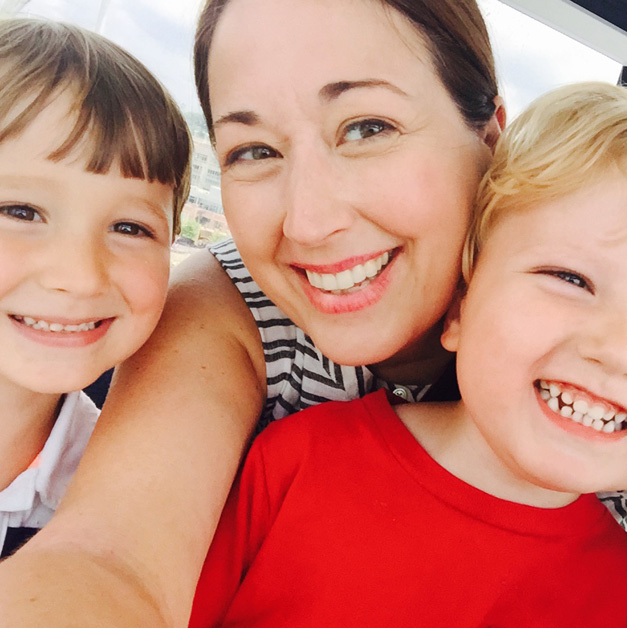
Cindy Hooks Morrison, M.S., CCC-SLP, CLC
Does your child ever interrupt you when you’re speaking?
There are times when my child’s sweet little mouth erupts like a tiny volcano forcing words out into the air! It’s usually perfectly timed with an inopportune moment, such as when i’m answering the phone, trying to exchange information with another person (i.e another parent, a cashier, a librarian, a teacher), on a business call and especially when daddy comes home.
At times when my full attention is not on my sweet little boy, he often seeks it back, by letting words spill out across his tongue while i’m engaged with another person. This causes a break in my communication and let’s be real…it can be frustrating for everyone involved in this scenario. My son does not mean to cause harm. This act is simply age-appropriate as he continues to learn how to use language in social situations.
One of my favorite quotes is “we spend the first few years getting our children to speak and then start telling them to be quiet.” The truth in this statement is that we do want our children to speak and use language to communicate greetings, thoughts, ideas, requests, promises, information, hopes, dreams and their wonderful silliness, but in addition to teaching them how to talk, it’s equally important to teach them the language rules for having a two-way conversation. We don’t really want them to be quiet, we just want them to wait for their turn.
Learning to wait to speak is called conversational turn-taking and it is a social-communication or pragmatic skill. Children learn this skill through observing the adults in their lives, but often children need more direction. Pragmatic language skills are less often discussed when it comes to teaching language, but these skills are very important to master.
There is a lot happening in the brain during a two-way conversation. Here’s a simplified version of what your child’s brain is working on during conversations with you and others each day.
Children must learn to decipher all the different ways language is being used (language usage) and when to use it. Are they simply giving a greeting by saying hello or good-bye to a friend or do they need to use their words to explain or inform an adult or peer about something that happened? Are they trying to express that they need help, (i.e. Mommy, I need my cup.) communicate a promise to do something in the future (I will pick up my toys after I find my back pack) or are they using language to ask for information instead of giving it? (i.e. Mommy, what makes the Spring flowers grow? Where did my brother go?).
In addition to deciphering how they need to use language, they also need to learn how to change the way they use language based upon the needs of the listener. For instance, my son who is age four, already uses simpler language when he is speaking to his baby brother than when he is speaking to an adult or a peer of the same age. When we are speaking to another person our brains are actively monitoring what our conversational partners are saying, reading their body language to understand what they are feeling and then formulating a response, retrieving the words from memory, lining the words up in correct order, finding and lining up those phonemes or sounds that make up each of these words and sending messages to the muscles of the oral cavity to begin the fine motor, muscular movement required to speak that reply. All of this happens in seconds. It’s rather miraculous when you really think about it.
Have you ever used the expression, “you need to use your inside voice?” This is another example of how you are teaching your child how to change their language based on the communication partner, the location or setting.
Lastly, from the time your child has been able to focus his or her eyes on you, he or she has already started learning the “hidden” rules of social language. These rules include using and reading facial expressions and eye contact to gain information and monitor the reaction that your words have on the other person you are speaking with. These rules also include how close to stand to someone you are speaking to, how to stay on topic, how to introduce thoughts and ideas at the appropriate time and in the correct order…and if all of that wasn’t hard enough, children need to wait for their turn to do all of this.
I’m not sure how your little one feels about waiting, but mine isn’t always a fan. He’s four and waiting is no fun, so sometimes interruptions happen. Here are some of the strategies that i’ve used successfully at work and at home to work on conversational turn-taking/waiting to reduce interruptions.
Step One
Saying excuse me. The first step in teaching your child the hidden rules of social communication should always be teaching them to look. Look at mommy’s face and her mouth. If her mouth is moving and her face is looking at someone else, mommy is talking. If you want mommy to look at you, you need to start by saying “excuse me.” This skill goes beyond good manners, this is teaching your child to make observations of a speaker.
Praise your child whenever you hear the words “excuse me” come out of their mouths and initially it’s important to give them immediate attention to reinforce this behavior. Try not to rush these steps. Take a week or two or even three to reinforce this. Children learn through repetition and they learn best when their foundation is solid before building upon it.
Step Two
You will know when your child has mastered saying “excuse me.” I remember that soon after teaching my son step one, I started getting the rapid fire of “excuse me, mom, excuse me, mom, excuse me mom, excuse me, mom!” Once this behavior had emerged, I smiled and knew it was time we started working on the next step.
I had a conversation with my son (more than once for the sake of learning through repetition) where I calmly explained that sometimes when he says “excuse me” I can not stop right away and that even though it’s really hard, he has to wait his turn. He was bummed to hear this news. I told him it was important to wait, because it meant that I would hear all of his important words and not miss anything. Just as I want him to listen to me when I am speaking to him, I want to honor him when he needs to speak to me by giving him all of my focus and attention.
I’ve taught him that when I hear him say “excuse me” that I will let him know I heard him by saying, “I hear you and I will be right with you.” This phrase lets him know that I did hear that he wants me and that he has to wait.
I further explained that when I turn my face to look at him that it means I am ready to listen and speak with him. This step teaches him to wait and simultaneously keeps him focused on observing me. This observation time is important because he is learning through watching my turn-taking and how I am using and changing my own language in the conversation.
This second step takes time. It’s going to require your patience. Each time your child interrupts consider it a golden opportunity to keep reinforcing these steps for building a future with less interruptions.
There is a wonderful book called, My Mouth is a Volcano by Julia Cook. The book is about a child that just can not wait to get his words out. He tries really hard to keep them in, tucked behind his teeth and lips, but sometimes they just burst out! It happens to the best of us – even to adults!
This book is enjoyable for children and provides a great reference to use when interruptions occur. It’s simple to say, “Oh no, your mouth is a volcano and it just erupted words every where. Please wait your turn and mommy will give you all of her attention in just a few minutes.” I’m always amazed by the difference I see in just a few weeks of using these strategies.
Children aren’t actively trying to cause communication break downs and frustration. They are learning to master social communication skills and it’s important work. Use interruptions as teachable moments and celebrate your child when they do not interrupt to reinforce their wonderful work!
If you are interested in seeing age benchmarks for social communication you can find them by clicking here.
If you are concerned that your child is not meeting his or her age-appropriate speech, language and/or social communication milestones, please discuss these concerns with your pediatrician.
Get your copy of My Mouth is a Volcano by Julia Cook by clicking the photo above.





Great advice, Chew Chew Mama! Now, what if your pediatrician is just way too lassez faire with your concerns? Any thoughts on other resources?
Thank you for your sweet comment and for your great question! If you feel that your pediatrician isn’t as concerned as you are don’t let the issue be put to rest. You are always your child’s BEST advocate. Keep the dialogue open with your pediatrician. Pediatricians only get to see a small snap shot of what your children are doing during their well visits and rely on your parent reporting to give them clues in this area. It’s ok to be direct and ask for a referral to have your child evaluated by a speech and language pathologist if you are concerned about their social communication. It never hurts to see an expert in this area to make sure you are meeting your child’s needs. Message me if I can help!